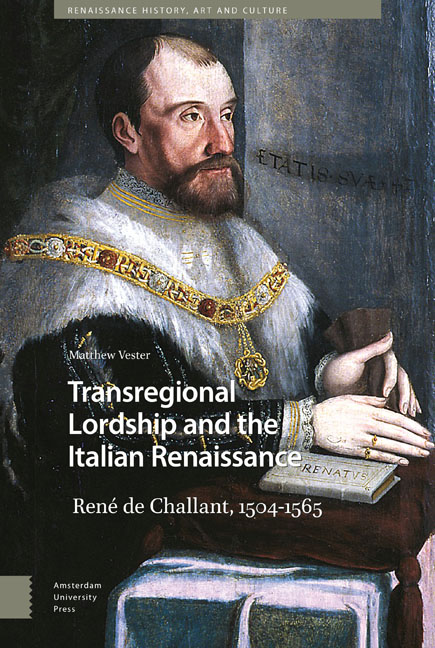Book contents
- Frontmatter
- Contents
- Maps and Tables
- Abbreviations
- Acknowledgments
- 1 On the edge of the Italian Renaissance
- 2 René's early career to 1536
- 3 René's growing influence during the war years, 1536-1553
- 4 René and Duke Emanuel Filibert
- 5 Kinship and noble life
- 6 The Challant political networks
- 7 Finance and brokerage
- 8 Lordship
- 9 The embodiment of spatial politics
- About the author
- Index
9 - The embodiment of spatial politics
Published online by Cambridge University Press: 21 November 2020
- Frontmatter
- Contents
- Maps and Tables
- Abbreviations
- Acknowledgments
- 1 On the edge of the Italian Renaissance
- 2 René's early career to 1536
- 3 René's growing influence during the war years, 1536-1553
- 4 René and Duke Emanuel Filibert
- 5 Kinship and noble life
- 6 The Challant political networks
- 7 Finance and brokerage
- 8 Lordship
- 9 The embodiment of spatial politics
- About the author
- Index
Summary
Abstract
The practice of lordship in which René de Challant engaged was determined in large part by the spatial configuration of his lands and activities. In that sense, his case was singular, which offers a reminder that consideration of specific context is important for any discussion of Renaissance political culture. Indeed, the importance of material, spatial context seems to have permeated the very language used by René and his correspondents. Words and expressions denoted an understanding of authority as embodied, personal, and linked to concrete acts of lordship. This view of political culture was perhaps a late medieval one related to the notion of natural law inhering in things, different from a soon-to-emerge early modern one that abstracted individual rights from their spatial contexts.
Key words: spatial history, embodiment, political language
This book has demonstrated that René de Challant was a transregional lord who served not only the House of Savoy, but also the King of France and the Holy Roman Emperor. He also exercised lordship himself, inheriting and defending his own sovereign claims while simultaneously considering himself a bourgeois of Berne. Since most of his lands were situated in the Valle d’Aosta, and because of his family's deep ties to the Sabaudian dynasty, he represented a forgotten dimension of the Italian Renaissance – its links with transalpine society and its often lordly and feudal character. The first, narrative part of the book shows how frequently René's political activities, both on behalf of the dukes of Savoy and in his own interest, carried him beyond northern Italy into the French, Habsburg, and Swiss lands. The thematic chapters in Part 2 clarify how the spatial diversification of the Challant fiefs affected René's political influence, in terms of kinship and family relations with other nobles, his political networks, his role as a financial broker, and his activities as a fief-holder.
Previous scholarly work on René has rarely been rooted in archival sources, the Challant corespondence in Aosta remaining unexploited. It has almost always depicted René in relationship to the dukes of Savoy and the Sabaudian state (especially during the 1860s and the 1920s), rather than considering him in relation to the political and institutional structures of the Valle d’Aosta or the lands of his other domains.
- Type
- Chapter
- Information
- Transregional Lordship and the Italian RenaissanceRené de Challant, 1504–1565, pp. 287 - 308Publisher: Amsterdam University PressPrint publication year: 2020



